Ordnance Survey maps of a hundred years ago show that the Vale of Evesham was once covered with orchards. But the maps give no indication of the variety of fruit that was grown. Some information about this can be found in the Land Valuation Survey 1910 - 1915. Although most growers in Badsey, Aldington and Wickhamford only recorded that they grew plum or apple trees, a few did record the names of the varieties that were grown. These are listed here with some notes and illustrations. By far and away, Pershores were the most popular plums to be grown, followed by Victorias and then Prolifics and damsons.
One particular grower, Henry Masters of Longdon Hill, Wickhamford, grew almost all the varieties listed here. In the land valuation schedule this was at 'Sunnybank', number 961, with 4 acres of fruit trees. This field is on the north side of Longdon Hill. Today, as you come over the brow, from Evesham, on the A44 dual carriageway it is the first field on your left. It is now pasture.
Plums
Autumn Compote
Origin - Raised at Rivers' Nurseries, Sawbridgeworth, Hertfordshire and introduced in about 1840.
Fruit - A red culinary plum of medium size and sharp flavour.
Season - Late season harvest.
1910 - 1915 valuation survey records naming this variety - 961 where it is called 'Autumn Comps'.
The illustration is from the Keepers Nursery website, copyright © 2014.
Belle de Louvain
Origin - From Belgium originally.
Tree - Upright and compact with large serrated leaves. Slow cropper
Fruit - Large plum, oval, flattened on one side. Red when picked ripening to dodge- purple.
Flesh - Yellow flesh.
Use - Culinary - excellent cooker, poor dessert. Good for jam but too big to bottle or can.
Season - end of August.
1910 - 1915 valuation survey records naming this variety - 961
Coe's Late Red
Origin - Possibly a cross between a Greengage and a White Magnum Bonum. Late 18th century. Developed by Jervaise Coe a gardener at Bury St. Edmunds, Suffolk.
Tree - self-sterile. Gives a good crop when cross-pollinated.
Fruit - Large oval and deep crimson.
Flesh - golden yellow, tender and very juicy - high flavour.
Use - dessert
Season - End of September.
1910 - 1915 valuation survey records naming this variety - 961
Can you help us and provide an illustration of Coe's Late Red? The variety is also known as 'St Martin'.
Czar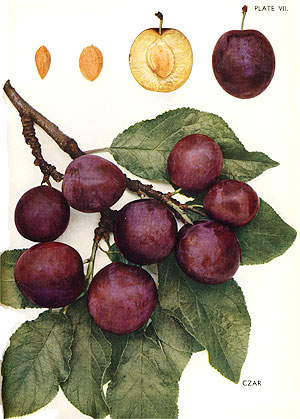
Origin - Raised by Thomas Rivers from Prince Englebert crossed with Early Prolific. First fruited in 1874. Named Czar in honour of the visit of the Russian Emperor in this year.
Tree - medium growth, compact. Reliable cropper and thought to be frost resistant.
Fruit - round or oval. Colour dodge-purple.
Flesh - yellowish-green, tender, slightly acid.
Use - Culinary - satisfactory cooker and canning fruit.
Season - Early August. The first crop to be produced in quantity.
1910 - 1915 valuation survey records naming this variety - 961
Damson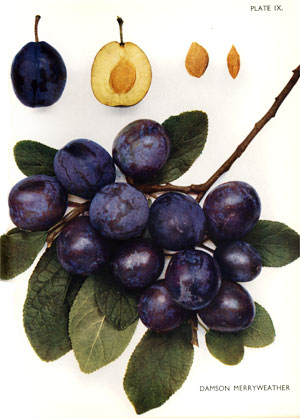
Origin - A group name for various varieties. The variety illustrated is Damson Merryweather.
Fruit - round. Colour nearly black to purple.
Flesh - Dry to acid.
Use - Culinary - excellent for cooking, preserving, bottling and canning.
Season - End of September.
1910 - 1915 valuation survey records naming this variety - 73, 956, 959, 960, 1030
Early Prolifics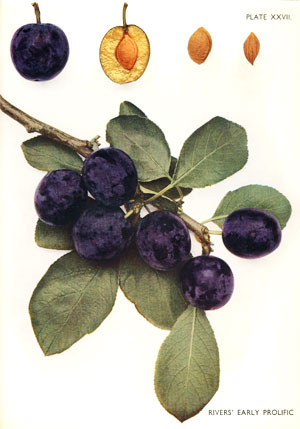
Origin - A Thomas River plum from Sawbridgeworth in Herts c.1830. Immensely popular.
Tree - Compact with slender branches, leaves having crenated margins - must be cross-pollinated.
Fruit - small, round, purple colour with lavender bloom.
Flesh - golden-yellow, firm, juicy, sweet and flavoursome.
Use - Culinary - excellent cooker, canning and bottling. Eating when ripe.
Season - early September.
1910 - 1915 valuation survey records naming this variety - 73, 956, 961, 975
Heron
Origin - Thomas Rivers's introduction in 1888.
Tree - tall, upright, vigorous growth. Leaves average and oval. Good cropper.
Fruit - round, medium size. Colour blue always mottled with patches of purple and some red lines.
Flesh - firm.
Use - Culinary - juicy cooking plum.
Season - Mid August.
1910 - 1915 valuation survey records naming this variety - 961
The illustration is from the Harrod Horticultural website, copyright © 2014.
Monarch
Origin - Thomas Rivers's introduction 1885 to provide market with late plums.
Tree - large, tall upright growth and very vigorous. Leaves large and almost round. Self fertile.
Fruit - roundish to oval purple in colour with some white dots.
Flesh - firm, not juicy and not much flavour.
Use - Culinary - cooks well
Season - End of September.
1910 - 1915 valuation survey records naming this variety - 956, 961
Orleans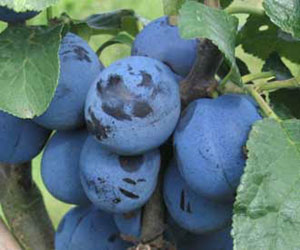
Origin - An old plum from France.
Tree - growth weak and upright. Leaf very large and roundish.
Fruit - round with flat end. Colour dark blue with heavy blue bloom often appearing mottled.
Flesh - juicy and sweet .
Use - culinary.
Season - Mid August.
1910 - 1915 valuation survey records naming this variety - 961
The illustration showing the Early Orleans plum is from the Keepers Nursery website, copyright © 2014.
Pershore ( yellow egg)
Origin - Thought to be chance seedling found in a wood in the Vale of Evesham.
Tree - medium, compact spreading. Disease resistant to silver leaf and canker in part. Leaves broad oval, thick and tough. Self fertile. Prolific and regular cropper.
Fruit - canary yellow and oval in shape.
Flesh - very firm, yellow, dry and without flavour.
Use - Culinary - usually picked firm and green for cooking, jam making and canning. High quality. The principal plum used for these industries.
Season - Ripens to yellow at the end of August.
1910 - 1915 valuation survey records naming this variety - 73, 959, 960, 961
Shropshire Prune Damson
Origin - Probably a wild seedling cultivated.
Tree - dwarf to moderate size, round with small oval leaves. Consistent cropper.
Fruit - oval to oblong. Colour very deep purple, a dense bloom that easily rubs off.
Flesh - firm, sugary and astringent, choicest of all the damsons.
Use - Culinary - excellent for cooking, preserving, canning and bottling.
Season - late September.
1910 - 1915 valuation survey records naming this variety - not named specifically but a frequently grown damson.
Victoria
Origin - Chance seedling found in a garden in Alderton, Sussex introduced in 1840.
Tree - medium size and spreading, branches brittle that break with heavy crops. Leaf large, long and a shiny light green. Self fertile and regular cropper.
Fruit - oval with deep suture line. Colour - pink to Carmine Rose with pale blue bloom usually with dots of a deeper red.
Flesh - grained, pinkish, firm, juicy and sub acid.
Use - Culinary - canning, bottling and jam making in the highest class - one of the most profitable. Dessert.
Season - mid August for the markets and ripe for dessert end of August.
1910 - 1915 valuation survey records naming this variety - 956, 961, 975
White Magnum Bonum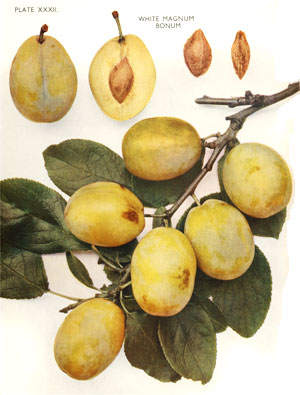
Origin - Thought to be old French. Some think it is the same as the Yellow egg plum.
Tree - growth vigorous, large and upright with spreading branches. Leaves small, oval and light green.
Fruit - large and long oval. Colour citrus green with bluish-green bloom.
Flesh - clear yellow, grained, firm, dry with little flavour.
Use - Culinary - cooker but excellent canning and bottling.
Season - first week of September.
1910 - 1915 valuation survey records naming this variety - 961
Apples
Bismark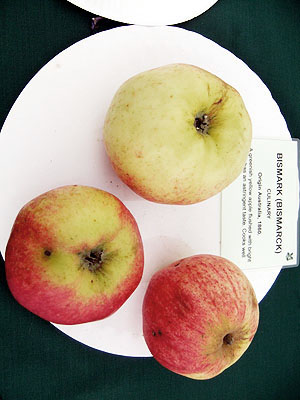
Origin - Raised in Hobart, Tasmania and imported to the U.K. Not a popular commercially grown apple.
Fruit - Conical- shaped apple, greenish-yellow overlaying dark crimson patches.
Flesh - crisp, juicy and sub-acid.
Season - Supplies market in September to Oct.
1910 - 1915 valuation survey records naming this variety - 961
Ecklinvilles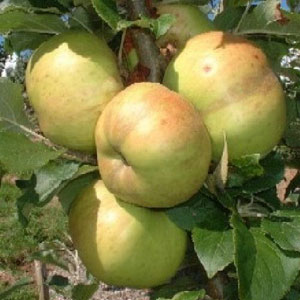
Origin - An apple found in Ireland at Ecklinville, four miles from Portaferry . A local gardener named Logan cultivated it c. 1820.
Fruit - Large and roundish, vivid green changing to bright yellow in November with russet dots, sunny side flushed with crimson.
Flesh - Pure white, soft and acid.
Use - Culinary, a cooker.
Season - September to October.
1910 - 1915 valuation survey records naming this variety - 956, 961
The illustration is from the Irish Seed Savers website, copyright © 2014.
Grenadier
Origin - Not recorded but probably around many years.
Tree - moderate size with excellent fertility.
Fruit - large, round pale yellow smooth skin with russet dote.
Flesh - white, crisp and acid.
Use - Culinary, an early cooker.
Season - Supplies market in September to October.
1910 - 1915 valuation survey records naming this variety - 961
Lord Grosvenor
Origin - Unknown. Very fertile.
Fruit - Long, conical and irregular in shape. Pale yellow skin.
Flesh - white, juicy and acid.
Use - culinary, good for cooking.
1910 - 1915 valuation survey records naming this variety - 961
The illustration is from the Keepers Nursery website, copyright © 2014.
Lord Suffield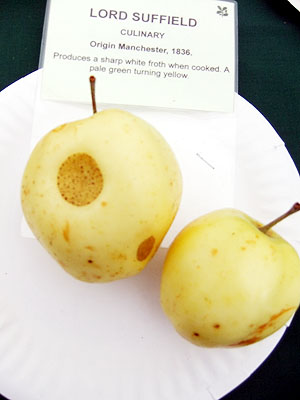
Origin - Raised in 1831 by Thomas Thorpe, a handloom weaver on Lord Suffield's estate at Middleton, near Manchester.
Tree - Tall and upright. Great favourite in private gardens.
Fruit - Oval to conical, clear light yellow skin.
Flesh - very soft.
Use - culinary, grown to supply an early cooking apple.
Season - August.
1910 - 1915 valuation survey records naming this variety - 961
Newton Wonder
Origin - Raised by Mr. Taylor of Kings Newton, Derbyshire. Introduced commercially in 1887.
Tree - Vigorous growth with much bare wood. Blossoms late.
Fruit - large and round. Skin tough and smooth with yellowish-green with pale crimson flush. Large core.
Flesh - yellow, firm, crisp, juicy and acid with slight bitterness.
Use - Culinary. Cooks excellently.
Season - Marketed in December but keeps well up to April.
1910 - 1915 valuation survey records naming this variety - 961
Stirling Castle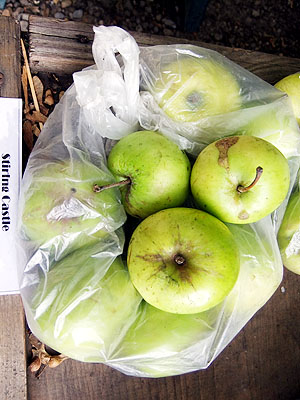
Origin - Grown by cottagers in the Stirling area. Introduced in the 1830s commercially.
Tree - Very fertile.
Fruit - Round, flattish and regular. Skin is pea green changing to yellow with a faint blush.
Flesh - Quite white, very tender, juicy and acid.
Use - Culinary.
Season - Early apple may be marketed in August to September though a better flavour in October.
1910 - 1915 valuation survey records naming this variety - 961
Worcester Pearmain
Origin - Introduced around 1873 commercially. Believed to be raised by Mr. Hale of Swan Pool, near Worcester.
Tree - Round in shape and conical in height.
Fruit - Skin thick, tough and smooth, brilliant red in colour.
Flesh - White, crisp, sweet and juicy with faint strawberry flavour.
Use - Dessert. The most popular market dessert apple grown in GB. Pleasant eating.
Season - September to October.
1910 - 1915 valuation survey records naming this variety - 961
Some of the illustrations have been copied from H.V. Taylor's two books in the Badsey Society archive, "The Apples of England" (1936/1948) and " The Plums of England" (1949).
This information was compiled by Jane Neill with some additional material by Tom Locke.
